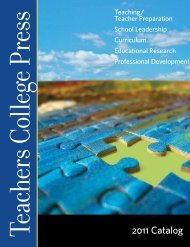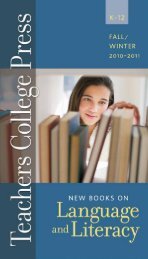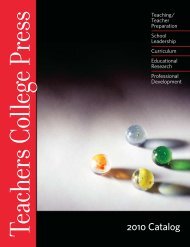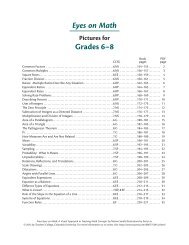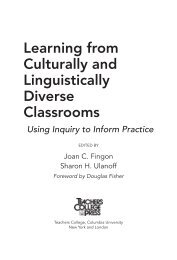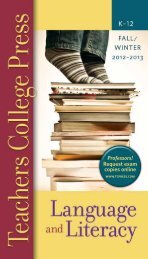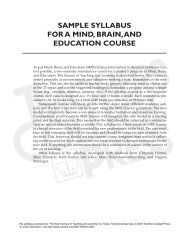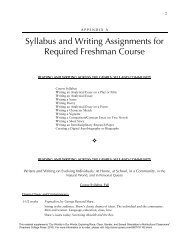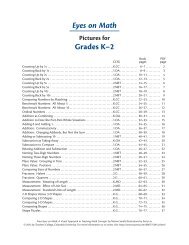Spectacular Things Happen Along the Way - Teachers College Press
Spectacular Things Happen Along the Way - Teachers College Press
Spectacular Things Happen Along the Way - Teachers College Press
You also want an ePaper? Increase the reach of your titles
YUMPU automatically turns print PDFs into web optimized ePapers that Google loves.
projects within <strong>the</strong> broader world of curriculum design, leading you to identify <strong>the</strong><br />
curriculum visions, learning objectives, and sources of knowledge that could be<br />
addressed in a social action project. You will also consider some of <strong>the</strong> possible student<br />
responses.<br />
Focus Question: How can I enact a social action curriculum?<br />
1. Create a timeline reviewing main events of Room 405’s social action project.<br />
Star <strong>the</strong> events during which Schultz modeled a teaching move that you would<br />
like to integrate into a social action curriculum in your classroom.<br />
2. Utilize a KWL chart to record your learning about social action curriculum.<br />
KWL charts contain three columns which record WHAT YOU KNOW, WHAT YOU<br />
WANT TO KNOW, and WHAT YOU LEARNED about a certain topic. Begin by filling<br />
<strong>the</strong> first section of <strong>the</strong> chart with examples of what you know about social action<br />
as a result of reading <strong>Spectacular</strong> <strong>Things</strong> <strong>Happen</strong> <strong>Along</strong> <strong>the</strong> <strong>Way</strong>. Then, draft a<br />
list of questions about what you still want to know about social action curriculum<br />
in <strong>the</strong> second column. As you design and enact your own curriculum and/or<br />
pursue additional research on this topic, document what you learn in <strong>the</strong> third<br />
column.<br />
3. Write a poem, narrative, or expository essay reviewing <strong>the</strong> values, assumptions,<br />
and <strong>the</strong>ories that you would like to address in a social action curriculum. To<br />
guide your work, consider <strong>the</strong> following questions: What do I believe about <strong>the</strong><br />
role of student voice in <strong>the</strong> curriculum? What do I believe about political<br />
participation for K–12 students? You may want to consider <strong>the</strong> values and ideals<br />
that Schultz shares on pages 11–16 to start.<br />
4. Brainstorm <strong>the</strong> community-based issues that <strong>the</strong> K–12 students in your classroom<br />
might choose to address in a social action project. Study <strong>the</strong> local newspaper to<br />
explore how different social problems are being reported and how <strong>the</strong>y may<br />
impact your students.<br />
5. Draw a neighborhood map that identifies different sources of geographic concern<br />
or interest in <strong>the</strong> community.<br />
6. Brainstorm various sources of knowledge (i.e., interviews with members of <strong>the</strong><br />
community, books, <strong>the</strong> Internet, print and visual media sources) that you could<br />
introduce to <strong>the</strong> students to help <strong>the</strong>m learn about <strong>the</strong>ir chosen issues from<br />
multiple perspectives.<br />
7. Brainstorm <strong>the</strong> audiences that a social action project might seek to reach.<br />
8. Review your state standards and identify those you would want to address within<br />
a social action curriculum.<br />
9. Draft a list of 2 to 3 skills that you wish for students to develop in <strong>the</strong> context of<br />
<strong>the</strong> social action curriculum. These skills should reflect practices that adults<br />
regularly use in real-life contexts. For example, you may want your students to<br />
read <strong>the</strong> newspaper and understand <strong>the</strong> author’s point of view about a social<br />
problem. Then, draft a list of 2 to 3 products that your students could create<br />
through <strong>the</strong> curriculum that are also seen in real-life contexts. You might want<br />
This Guide accompanies “<strong>Spectacular</strong> <strong>Things</strong> <strong>Happen</strong> <strong>Along</strong> <strong>the</strong> <strong>Way</strong>” (<strong>Teachers</strong> <strong>College</strong> <strong>Press</strong>: 2008).<br />
For more information or to order, please visit: http://store.tcpress.com/0807748579.shtml



